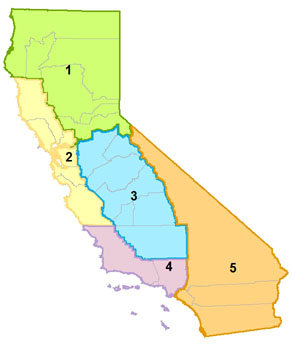

 |
 |
 |
The California Water Boards' Annual Performance Report - Fiscal Year 2015-16
REGULATE: PUBLIC WATER SUPPLY SYSTEMS |
|
|
||||
|
MEASUREMENTS
|
Division of Drinking Water (DDW) regions are different than Regional Water Quality Control Board regions. See the DDW Regional Office map below. |
FusionCharts will load here
|
FusionCharts will load here
WHAT THE MEASURE IS SHOWING
WHY THIS MEASURE IS IMPORTANT
 In order to ensure that Californians have access to a consistent and reliable source of safe drinking water, the state requires that all public water systems be permitted. Drinking water system permits designate a public water system, and ensure that a public water system adheres to the requirements of the Safe Drinking Water Act and the California Waterworks Standards. The permits are issued to new water systems before the system is allowed to operate, and the permits never expire. However, permits are amended when a public water system undertakes any action that may impact public health (such as adding a new source of supply, adding or substantially modifying drinking water treatment, or adding a distribution reservoir of 100,000 gallon capacity or greater). Permits are reissued whenever the original permit does not adequately describe the current system, when there have been numerous permit amendments to the original permit, or there are new special conditions that DDW deems necessary for the protection of public health. Permits may also be revoked or terminated. Typically, permit requirements remain in effect until the permit is amended or reissued. Issuing new permits, and amending and reissuing existing permits for public water systems requires a significant amount of time and resources, and is considered a good indicator of overall DDW program performance
In order to ensure that Californians have access to a consistent and reliable source of safe drinking water, the state requires that all public water systems be permitted. Drinking water system permits designate a public water system, and ensure that a public water system adheres to the requirements of the Safe Drinking Water Act and the California Waterworks Standards. The permits are issued to new water systems before the system is allowed to operate, and the permits never expire. However, permits are amended when a public water system undertakes any action that may impact public health (such as adding a new source of supply, adding or substantially modifying drinking water treatment, or adding a distribution reservoir of 100,000 gallon capacity or greater). Permits are reissued whenever the original permit does not adequately describe the current system, when there have been numerous permit amendments to the original permit, or there are new special conditions that DDW deems necessary for the protection of public health. Permits may also be revoked or terminated. Typically, permit requirements remain in effect until the permit is amended or reissued. Issuing new permits, and amending and reissuing existing permits for public water systems requires a significant amount of time and resources, and is considered a good indicator of overall DDW program performance
TECHNICAL CONSIDERATIONS
- Data Source: Division of Drinking Water district office survey. Period July 1, 2014 to June 30, 2015.
- Unit of Measure: Number of active public water systems as of June 30, 2015.
- Data Definitions: Permits Amended in FY 14-15: permit amendment with an issue date between July 1, 2014 and June 30, 2015. Permits Issued or Reissued in FY 14-15: permit with an issue date between July 1, 2014 and June 30, 2015.
- References:
GLOSSARY
Community Water System A Community water system is a public water system that serves at least 15 service connections used by yearlong residents or regularly serves at least 25 yearlong residents of the area served by the system.
Drinking Water System Permit (Permit) The drinking water system permit is an operating permit, not a construction permit, which never expires. The permit contains the operating provisions the water system must comply with, as well as an engineering report that includes a detailed technical evaluation of the water system facility.
Non-Transient Non-Community Water System A non-transient non-community water system is a public water system that regularly serves 25 or more of the same persons over 6 months per year, such as a school.
Non-Community Water System A non-community water system is a public water system that is not a community water system. This category of water systems includes non-transient non-community water systems and transient non-community water systems.
Public Water System A public water system is a system that provides water for human consumption through pipes or other constructed conveyances, if such a system has at least fifteen service connections or regularly served at least 25 people at least 60 days out of the year.
Transient Non-Community Water System A transient non-community water system is a public water system that does not regularly serve at least 25 of the same persons over six months of the year, such as a camp ground or highway rest stop.



